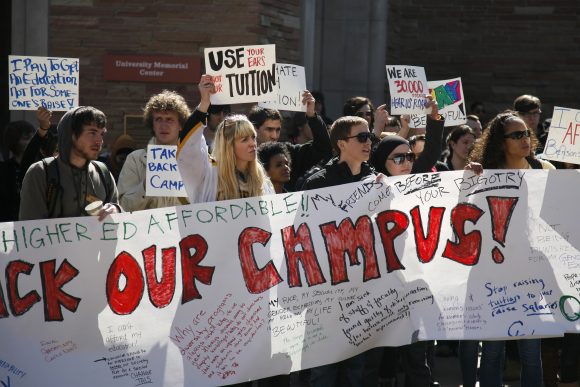
Students in the Take Back Our Campus movement gather in front of the UMC to protest tuition increases and a lack of diversity on campus in March 2012. (James Bradbury/CU Independent file)
Editor’s note: This story discusses CU’s diversity plan and references the plan’s official website at several points. We recognize the university may update the website. Our reporting takes into account what it displayed at the time of this publishing July 22.
Two days after Donald Trump won the presidency, students at CU Boulder walked into their class on race and ethnicity and had an emotional discussion about the election that brought some to tears. That particular day, they were joined by a white male wearing a Trump shirt and American flag-colored shorts. He was not enrolled in the class. He sat silent, in the front row, through several minutes of the discussion. Suddenly, he raised his hand to the mixed-race professor.
“I think I’m in the wrong class, but this is for you,” he said, approached her and then walked out. “Build a wall! Build a wall!”
He handed the professor a box of tissues.
Welcome to CU Boulder.
That’s the scene a student in CU’s Black Student Alliance recounted in spring semester 2017 as the university’s administration continued to work on a plan to improve diversity and inclusion that’s been in development for nearly three years.
The “comprehensive strategic plan,” as Chancellor Phil DiStefano called it, has created dialogue between students, faculty, staff and administrators, but the concrete changes it will bring to the campus remain vague and not obvious to the public.
The plan’s website lists dozens of academic reports, research and other writings as resources, but it does not list any specific changes planned by CU Boulder’s colleges, schools and other offices on campus. The site also says the plan would be implemented starting summer 2017.
Group interviews indicated most students likely do not know about the plan, despite CU telling the campus it would be publicly updated at key points in the process.
Aside from some staff taking a cultural awareness program and a focus on cultural issues in the classroom — and the controversial cutting of a diversity dorm hall program beloved by students for years — the overall scope of CU’s strategy remains unclear. A look into the process revealed a lack of public transparency that was promised about the plan and uncertainty about what it will ultimately be.
Students of color said they’ve experienced behavior in the classroom by other students that ranges from uncomfortable to outright racist and that professors don’t do enough to help.
The CU Independent talked to student groups of color and the CU administration to examine students’ experiences, what changes they want to see and what will actually come of CU’s plan to address the adverse state of diversity and inclusion on campus.
‘Have you ever been stopped by the police?’
For many students of color who talked to the CUI, race-fueled incidents in the classroom formed a common thread in which they faced singling out, aggressive tones and stereotyping.
Victoria Dadet, an officer of communications for BSA, told the CUI a white student shouted at a professor during a discussion about police brutality in her Introduction to Africana Studies class.
“I took a class that had a group of white guys who sat in the back and yelled at the professor, ‘This is bullshit, this class is bullshit and this professor is bullshit,’” Dadet said.
Other white students in the class did not react to the yelling, Dadet said.
Richardo Bambury, officer of finances for BSA, said he was singled out during his first month at CU in a class conversation about Mike Brown, who was shot and killed by police in 2014.
“A professor asked me, ‘Have you ever been stopped by the police?’” Bambury said. “I was the only black person in that class. I think he thought he could get the full explanation from me.”
Bambury told the CUI about the student in American flag shorts giving a professor a racially charged message and leaving tissues. The professor told the CUI she reported the incident and that a CU office identified the male as a student. Bambury heard the story from a friend he had in that class who shared a photo of the box of tissues at the time, which had a quip about Hillary Clinton taped to its side. The CUI did not publish the photo to protect a second friend’s identity.

Students from the Black Student Alliance protest then-President-elect Donald Trump at the UMC, Nov. 15, 2016. (Carina Julig/CU Independent)
Guadalupe Avalos, a member of UMAS Y MEChA, a Latino CU student group, said she felt pressure from a liberal professor to express how she feels about issues surrounding Trump.
Trump “comes up every day [in political science] classes … It’s normalized. It’s streamlined. It’s across classes,” said Robert De Mata, an UMAS Y MEChA member who said students of color have to contest offensive comments when professors won’t. “From a person of color’s [standpoint], it’s exhausting to have to do that.”
Multiple students in group interviews said they encountered Trump-like rhetoric about immigrants, Muslims or Middle Easterners in or out of the classroom.
“I’d agree with [De Mata]; there’s no effort to defend our side of it,” another student at the February UMAS Y MEChA meeting said. “They’re trying to remain neutral because they’re professors, and I get that, but sometimes, we need a little bit more.”
Heraa Hashmi, co-president of Muslim Students Association, said politics came up in class in October and she and her Latino friend felt out of place because their “lives are at stake, and consequences are very real for us.”
“One of my classmates and [I] had an argument about terrorism, and he asked me, ‘If Islam is peaceful, why are most terrorists Muslim?’ This was a lecture hall,” Hashmi said. “It got uncomfortable.” She said people were arguing around them, even though it was a talk-with-your-neighbor discussion.
For Garmai Matthew, a student at the BSA meeting, the discomfort came from being asked about race relations in class.
“In many cases, I was the only black person in my Chinese classes,” said Matthew, who also said her professors recently asked her questions like “How does it feel to be black in this campus climate?” and “How does it feel being black in your major?”
“I asked my professor, do you have any black friends? Let’s start there,” Matthew said. “Picking up a book, looking at our philosophers and thinkers [would help], rather than picking us off and thinking, ‘You can explain the whole black experience for all black people.’ I asked him, “What if I had asked you, ‘How does it feel to be a white male?’ and he said, ‘I never thought about it that way.’”
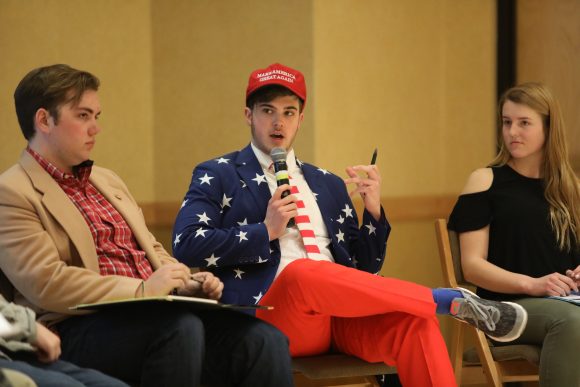
A Trump supporter at a panel discussion at the UMC argues why minorities should stand up for themselves without any help from white people. Feb. 8, 2017. (Jesse Hughes/CU Independent)
Another student said the campus climate has changed in the past two years “in an artificial way.”
“My professors are aware, but almost in a [complaining] way,” Ogechi Hippolyte said at the BSA meeting. “Yeah, [school emails about diversity] are annoying, but they don’t understand that’s making light of what students actually have to go through.”
Some professors ask how they can help, she said, “But it’s 75/25. Most are the snob comments.”
‘Stop letting people like Milo come to campus, first of all’
When asked what she’d like to see from the diversity plan, Dadet of BSA said the university shouldn’t let speakers like Milo Yiannopoulos, the alt-right, conservative former Breitbart News editor, hold events at CU.
Yiannopoulos’ Jan. 25 speech on campus drew two student petitions to cancel the event and moved more than 200 faculty members to urge CU to hold alternative events on the day of the speech. The group said it was spurred by the possibility a Yiannopoulos event would normalize hate speech. CU’s response said that was not the university’s intention and appeared to support the group’s push for more diversity and inclusion events.
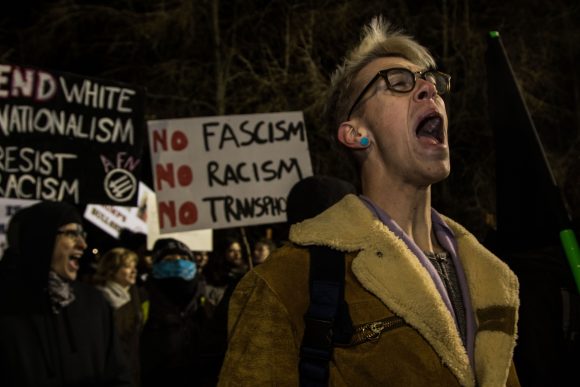
A protester chants during protests outside of Milo Yiannopoulos’s speaking event on Jan. 25, 2017. (Jackson Barnett/CU Independent)
The administration did not comment on the two petitions to cancel the speech, which drew hundreds of protesters, some of whom were violent. The University of California Berkeley and UC Davis canceled Yiannopoulos events within weeks of CU’s due to security concerns over protests. He’s known for anti-Muslim, homophobic, misogynistic and anti-transgender rhetoric, going as far as to harass a transgender student by name at the University of Wisconsin-Milwaukee. A spokesperson said CU administration was aware of that fact.
But heated discussions about diversity on campus started years before Yiannopoulos’ speech — and even before a 2014 survey put racial minorities’ discomforts at CU on the loudspeaker.
For one race, just 38 percent felt welcome at CU
CU conducts a Social Climate Survey, which asks students about their experience on campus, about every four years. The results of the 2014 survey were released January 2016 and showed stark disparities in students’ feelings across races.
Sixty-nine percent of white students said they felt welcome at CU, or “like they belong here.” The number was 61 percent for Hispanic students, 56 percent for Asian-Americans and 56 percent for Native Americans.
It was 38 percent for black students.
The results came on the heels of talks between BSA and Chancellor DiStefano in November 2015 amid unrest at the University of Missouri — commonly called “Mizzou” — where the school’s president and chancellor stepped down after protests over racial incidents on campus.
BSA shared stories of racial incidents and students being called “nigger” at CU in the past, and racist graffiti was found in a CU bathroom months after.
In the midst of the Mizzou unrest, DiStefano sent out in the university newsletter what appears to be the first announcement of CU’s diversity and inclusion plan Oct. 9, 2015. He said talks related to the plan — which one administrator calls the “Inclusive Excellence Initiative” — took place in May 2015. According to the diversity plan website, talks related to the plan date back to fall 2014.
The plan isn’t directed at racial issues alone, but interviews with administrators and the “resources” pages on the website focused on race and ethnicity more than issues about gender, sexual orientation, sex, religion or socioeconomic status. Panel talks regarding the Social Climate Survey results in spring 2016 largely centered on race, as did three focus groups of black students CU conducted in fall 2015.
Racial minority undergraduate students, especially black students, have generally expressed less positive feelings than white students about the campus through each of the six surveys — generally called campus climate surveys — since 1994.
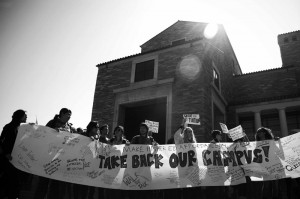
Students in the Take Back Our Campus movement gather in front of the UMC to protest tuition increases and a lack of diversity on campus in March 2012. (CU Independent/James Bradbury)
In group interviews in March, students told the CUI they want more diverse faculty, more sensitivity in class discussions, more communication with the administration and better funding for diversity-related programs. One of the most asked-for ideas has been a required class on multiculturalism — or understanding between different cultural groups — for all students. Students from the Muslim Student Association and the Middle Eastern Students Association said they wanted an adequate prayer room on campus.
Alphonse Keasley, an assistant vice chancellor and part of the steering committee — which partially oversees the plan — said, “Every layer of upper-level administration on the campus” is involved in the plan, officially named the Diversity, Inclusion and Academic Excellence Plan.
DiStefano has said CU is making this kind of effort for the “first time in our history.”
CU is paying $217,000 for outside help — so what’s in the plan?
Despite DiStefano telling the campus it would be updated on the planning process, few specifics have been released about what changes the plan will make.
In that October 2015 announcement, the chancellor explained that colleges, schools and administrative offices would submit findings — based on talks between deans, chairs, office heads and students — with recommendations to improve diversity and inclusion on campus.
Ideas from those bodies — often called “units” — would be condensed by the committee Keasley mentioned. That committee’s combined findings formed the starting point for the “collective CU Boulder plan,” DiStefano wrote.
DiStefano wrote that throughout the planning process, administration would “make the results known to the campus at key intervals through public and internal communications,” but units’ reports and recommendations have proved hard to find.
The website for the plan lists dozens of academic reports on criss-crossing issues of culture, racial bias and other forms of discrimination but does not offer a list of steps CU’s colleges, schools, administrative or other offices, or the campus as a whole has taken or will take. In the CU Independent’s inquiries to the chancellor and Provost Russell Moore for documents or records related to the plan, the CUI was directed to that site. Its materials appear to be exclusively written by professors and writers from other universities, academic organizations and other groups.
DiStefano and Moore were both interviewed in October 2016 after a report on the plan was privately presented to CU officials. DiStefano seemed to be unfamiliar with that meeting.
When asked about records related to the plan, Moore said certain information would be available on that website.
“The summaries, not the work products, but the summaries,” Moore said. “When we come to the milestone summaries, I believe the intention is to post those on the website.”
No summaries that involve recommendations — as DiStefano said units’ findings would involve — appear to have been posted as of this writing July 22. Instead, the website lists “resource articles, sorted by topic, that may provide useful information” about the concept of inclusivity in general. The articles tend to be dense and esoteric.
Moore did not respond in April when asked again about the summaries.
In October, Moore said he holds monthly meetings with chairs, deans, directors and vice chancellors on campus in which there have been “numerous discussions regarding culture and climate on campus.” He said there are close to 90 people that attend. As part of the plan, individual units would also try to improve diversity and inclusion within themselves, the website said.
A meeting on Oct. 14 included an external consultant who’s worked with other universities — CU Boulder has worked with Emeritus Consulting Group LLC, which it is paying $217,000 over “the next 30 months” to help develop the plan, the Daily Camera reported June 2015.
“What we’re trying to do is come up with something that, from the very grassroots on up, we can put together to say, ‘This really represents the campus’ priorities,’” Moore said. “It’s not just the department chair; it’s … his or her faculty, and they’re the ones that contribute to this. And then we’re bring the same things together from the student side of the house.”
Amid little information, most students did not know about a plan
In September, students received an update in the CU newsletter that said a “summary report” was being drafted based on the input from schools, colleges and offices on campus. Vice Chancellor Robert Boswell said the report would be shared in mid-October “beginning at campus governance meetings.”
One group of students saw updates from it, according to the Office of Diversity, Equity and Community Engagement, but it was not released in other ways.
“An inclusive excellence student advisory committee has been assembled under the leadership of Professor Erica Ellingson,” said Deborah Mendez-Wilson, a CU spokesperson. Those students attended the report’s presentation with department chairs and administrators Oct. 14.
Boswell’s September letter appeared to be the only public update sent to the whole campus about the process within about three years aside from the initial announcement. A brief mention came in DiStefano’s October 2016 State of the Campus address that echoed Boswell’s letter, and Boswell sent a cursory mention of the process in a January newsletter. CU recently invited new employees to an event where they were given some information about the plan May 19.
Boswell, who is black, led two sessions about the plan at CU’s fall 2015 Diversity and Inclusion Summit on campus a month after the plan was announced, DiStefano said at the time. He led another session at the February 2016 summit, where several attendees liked the idea but were unsure of how CU would find consistency if every department creates its own standards.
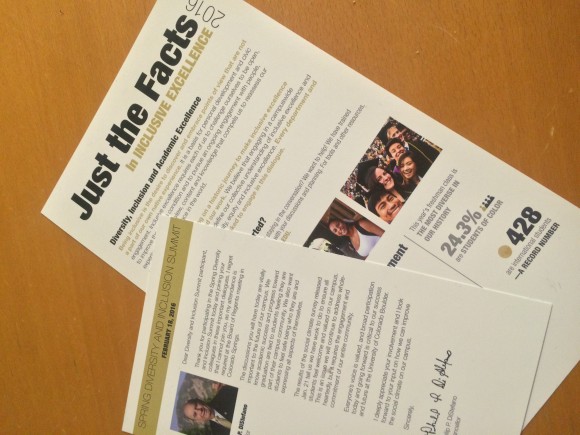
Fact sheets on CU’s diversity statistics from spring semester 2016. (Tommy Wood/CU Independent)
At the session, a person from the evolutionary biology department said he hadn’t heard of the plan and that it wasn’t introduced to his department. It was unclear whether CU shared details at those sessions other than those Boswell shared later in September or those DiStefano shared prior.
Of the roughly 50 students in group interviews with the CUI in spring 2017 — the vast majority students of color — less than half were aware of the plan.
When asked why there haven’t been more public updates to the whole campus, CU spokesperson Ryan Huff did not directly answer the question and did not point to any other such updates.
Huff mentioned several messages to the campus in recent years about diversity and CU’s semesterly Diversity and Inclusion summits, which are not mandatory to attend, but he did not point to any statements that gave the campus substantial information about the plan past what DiStefano’s initial announcement and Boswell’s letter detailed.
The plan’s “old timeline” — which lines up with the current timeline but is briefer — said information would be shared with the campus after units’ findings were reviewed, but details have not been publicly released as of this writing July 22. The old timeline’s link appeared to have been removed in June.
‘Put our money where their mouth is’ — what CU’s done so far
One student at the UMAS Y MEChA meeting said they want to see the school’s plan “put their money where their mouth is.” Another, later, emphasized: “[They need to] put our money where their mouth is.”
The plan’s website does little to identify the handful of concrete steps the administration is in fact taking toward addressing CU’s diversity problems. In one case, it appeared to contradict them.
The resources page featured one article written by a person, who is white, described as a blogger and head of a consulting company. It argues that cultural sensitivity training is “ineffective and insensitive” and says it “rubs me wrong.”
“First, it indirectly calls out a limiting belief that the solution is that ‘we’ need to be more ‘sensitive’ to ‘them,’” her piece reads. “This belief is well-intended, but often has negative effects.”
The piece equates calling for cultural sensitivity with implying that people of color “are fragile and need to be handled gently so you don’t break” and says it reinforces “a perceived or real power imbalance.” Instead, it calls for “intercultural effectiveness” but offers a vague definition of what that is and says little of how that would be achieved without some kind of program.
It continues, “Communities of color and non-dominant groups in general don’t want cultural sensitivity training, nor do they want to be the subjects of such training … Perhaps … the intended subjects of cultural sensitivity want something else. Have you asked?”
A student at the BSA meeting in March had a different answer.
“I think there should be a cultural sensitivity workshop for all professors,” Matthew said. “I could have handled [being singled out] in a much more negative way. I think that can be avoided if Caucasian professors [are more aware].”
A student at the UMAS Y MEChA meeting in February echoed that.
“It [would help if] you had people go through cultural competency training,” Adán García said. “That training preludes the actual teaching of [diversity] courses.”
Training for cultural differences and efforts for more diverse faculty
One concrete initiative CU has started is using an assessment about adapting to cultural differences, which is called the “Intercultural Development Inventory.”
The assessment tells staff how well they’re predisposed to adapt to different cultural perspectives. CU has trained some staff to help people who take it improve based on their results, according to Christina Gonzales, a vice chancellor who’s involved in CU’s use of the outside program.
As of April, CU had 45 of those qualified staff. The IDI is voluntary and has been open to faculty and staff in early 2017 — some students tried it in spring semester, and Gonzales said it will be available to more students in the fall. Top CU officials were passing it down through their teams as of at least Oct. 24, according to Gonzales, but Gonzales’ office did not say if faculty and staff were directly given notice of the program.
It’s not clear if the IDI is technically part of the diversity plan — it’s mentioned separately on some webpages — but it’s moving forward concurrently.
In late 2016, DiStefano said CU was “taking a look at” diversity training for new faculty and staff members.
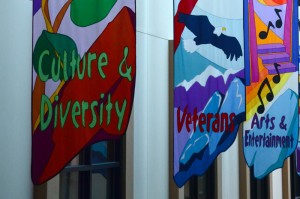
A banner that reads “Culture and Diversity” hangs in the University Memorial Center in 2012. The flag, which still hangs in 2017, seems to be a statement of CU’s support for diversity along with the ideas on banners next to it. (Annie Rumbles/CU Independent)
Shifting to students, he said CU already searches for diverse students and staff through the Office of Admissions and under Boswell but said he asked the office to see if it can do more recruitment for non-resident students of color — those who aren’t in-state students.
As for faculty and staff, CU is recruiting an official who will focus on recruiting diverse groups of candidates and educating search committees — groups that find new hires — to ensure equity in how CU recruits and hires, Mendez-Wilson said in April.
Similar measures coming for whole CU system
Outside of CU Boulder’s plan, for faculty, the CU system is developing new training for search committees to better understand unconscious bias and is examining its tenuring and promotion processes to eliminate any possible bias as well, President Bruce Benson said.
The board of regents will also hire a new position, a vice president for diversity and inclusion, to coordinate diversity efforts across campuses, Benson said.
The board postponed the hiring indefinitely in early April to wait on more information on how diversity and inclusion programs are performing across the CU campuses, said Patrick O’Rourke, a CU system official. What the position will entail was still in the works as of late April, O’Rourke said.
Will CU have a mandatory class on diversity?
Yes, no and maybe.
In 2015 and 2016, students in BSA were asking for a mandatory undergraduate class on diversity, race relations and microaggressions — subtle instances of offensive behavior or speech.
DiStefano said CU is expanding its diversity class requirement for some students, but several officials said a mandatory multiculturalism class for all freshman would not happen. They said it’s been tried before — on a small scale — to little success. Student leaders have criticized the way CU has outlined diversity requirements in the past.
“One of the things we talked about was, what kind of action, steps, can we take?” DiStefano told the CUI in October. As part of the new Arts and Sciences core, there will be two diversity credit requirements, the first of which focuses on United States diversity issues, DiStefano said. The other will focus on global perspectives.
DiStefano said there are some current classes that would likely meet that requirement, but there will also be new ones developed. He added that CU wanted to make sure faculty were aware of the 2014 Social Climate Survey results while working on the new classes.
The undergraduate requirement would apply to College of Arts and Sciences students — who made up 69 percent of incoming freshmen in 2015 — but other colleges, like engineering and business, can use other requirements. DiStefano said he “would hope that all” academic departments would be under the requirement, but that may not be the case.
When asked about a required first-year class, DiStefano mentioned that a new first-year seminar program could add to the pool of multicultural-focused classes, but cultural or racial diversity seems to play an up-front role in only a handful of those courses.
Vice Chancellor Keasley, who is black, said he was involved when some CU officials were trying to create a mandatory multiculturalism class in 2007–2009 that never materialized. He said he was one of three people that helped write the syllabus, but it didn’t go forward.
Boswell, a vice chancellor, said CU has tried the idea in a small group setting and “it didn’t work out that well.”
“The course was ARSC 1001, ‘The Research University and Student Citizens,’” spokesperson Mendez-Wilson said. Course topics included personal values, cultural differences, student conduct and intercultural community development on campus, she said.
Baker Hall originally housed the course, but it was moved to Cheyenne Arapaho Hall. Students in that hall were unhappy about being required to take it while other first-year students weren’t — it was easily evidenced on the Faculty Course Questionnaire feedback to faculty, Mendez-Wilson said.
Despite that, an outside research firm made the recommendation for CU to keep the class, and many of the students expressed interest in it being continued, Mendez-Wilson added. But it was ultimately cut, in large part “due to campus opinions and students’ dissatisfaction” as indicated on FCQs, she said.
Students favor that kind of class, criticize past diversity course requirements
Students of color said they were in favor of a mandatory class for all students and also said the way CU has defined its past diversity requirements for some students is too broad.
“I think it would be beneficial for everybody. To understand that just because this person went through this, not everyone went through it as well … to just check how you [interact] with people,” said Bambury, at a BSA meeting in March.
“I think that [a required class] is a good idea, but I feel like some people will use that class as an excuse to attack black people,” Dadet of BSA said before telling her story of the male students yelling in her class.
Students at the UMAS Y MEChA meeting in February said they think the usual type of requirement is not enough.
“There’s a diversity requirement, but it’s [broad],” De Mata said of requirements for some students at the time.
“They should steer away from intellectual diversity [in the requirement],” García said. “You can open that up so far that you end up with no diversity in your classroom … it can’t be the abstract intellectual diversity” that “ignores efforts for diversity of identity and background.”
Of the roughly 100 courses under in the new requirement as of March 2017, only a handful seemed to risk veering into over-broad territory — like ‘Ancient Astronomies of the World,’ ‘Geography of China,’ ‘World Musics’ and ‘Yoga: Ancient and Modern’ — but many appear to focus squarely on political and social issues of culture. Whether the requirement can be applied to all students outside the College of Arts and Sciences remains to be seen.
But professors will change classroom environments, CU says
Older students will remember the panel and group discussions the administration put on in spring 2016 after the Social Climate Survey results rippled through campus — Diverse Learners Awareness Week, which focuses on disabled and other minority students, was also created at about that time — and officials said in May that talks to change classroom culture are continuing.
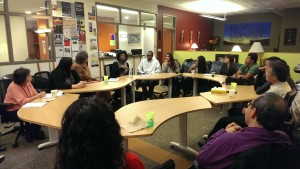
A CU student tells a group of about 19 people gathered in the C4C’s Center for Multicultural Affairs office about her perception of a racially adverse campus climate. February 2014. (Alison Noon/CU Independent)
CU calls the topic “inclusive pedagogy,” which refers to the way faculty conduct themselves in class.
Moore said CU is trying to look at what resources it can provide faculty so they’re equipped to respond to uncomfortable conversations or other student-to-student cultural issues in class.
Activities to promote inclusiveness in the classroom began in spring 2017 in collaboration with the Faculty Teaching Excellence Program — a group of CU faculty who design classroom methods — and CU’s Graduate Student Part-time Instructor Program, Mendez-Wilson said. They will continue to be developed, she added.
Summer 2017 is implementation time, website says — what’s actually going to happen?
Because of scant public information about what the campus is collectively planning, it’s difficult to say whether the final diversity plan will be implemented on time.
Aside from class- and faculty-related programs already underway, based on information given to the CU Independent and on the plan’s website, it is unclear what, if anything, will be put in motion this summer, fall and beyond.
The administration did not respond when asked twice if the plan is on track to be implemented in fall 2017, the time at which DiStefano told the CUI he’d like to see it underway. CU also did not respond when asked twice if there will be a university-wide implementation of some policies or if individual units will begin implementing their own strategies at that time, despite answering other questions the CUI asked.
Previously, DiStefano had said the plan would result in a “unified, complete and transformative campus effort” that would affect the “entire campus community,” and the plan’s website said there would be collaboration across units — colleges, schools and offices.
In fall 2016, the chancellor told the CUI that the university hopes to implement and announce to all students some of the “things we’re working on” regarding the plan in spring 2017, but that deadline appears to have been missed. When asked if that goal was postponed, the university did not respond.
Will the plan be ‘comprehensive’ and ‘transformative’? Hard to tell
To be sure, the steps of the plan do include individual colleges, schools and offices brainstorming and implementing their own ideas, but after that, the plan and statements by officials have suggested there would be a broader effort. Moore said the aim is for “cultural change on campus.”
Gonzales said that after getting input from different bodies on campus, “there will be a campus plan.”
In May, when asked about the overall planning process, the administration said, “Some common themes” that have emerged from the process campus-wide include “inclusive pedagogy, culture and climate, representation and communication.” CU also said that going forward, the process will encourage collaborations between departments and other offices toward those ends. But the plan’s timeline says the “collaboration” phase should have ended in the 2016–2017 school year, making way for the “implementation” phase of the plan.
Directions from Moore and Kelly Fox, CU’s senior vice chancellor and chief financial officer, instructed all units to develop plans that include “practical mechanisms and practices” regarding diversity and inclusion, ways the plans’ principles can be built into curriculum and staff operations, and how units can best work together. That was to be completed by Aug. 10, 2016, the documents said, although participation was not mandatory, Keasley said.
Details about the plans and how they have been or will be spread across entities on campus appear not to have been made public, despite DiStefano’s comments and the original timeline on the website.
The input was broad, though. More than 90 percent of campus units submitted plans that CU leaders reviewed during summer 2016, Boswell said in his September letter. But as of May, there was no word on whether more voices on campus chimed in. CU did not respond when asked about that.

CU staff members ask how they can encourage diversity and excellence during a CU Staff Council meeting organized as part of the spring Diversity and Inclusion Summit. Boswell, center, in blue with glasses, attended Feb. 21, 2017. (Jesse Hughes/CU Independent)
Despite the slim specifics about the plan, there is a laundry list online of steps CU planned to take in the wake of the Social Climate Survey’s release that appears to be in some way separate from the diversity plan. Parts of the diversity plan — discussion across units as well as the IDI testing — appear to be two of the steps listed on that other webpage.
Aside from a new discrimination and harassment policy July 2016 and a social justice-themed student retreat in February, it’s unclear which of those steps have been completed. The CUI was told of only two of the steps when asking CU questions regarding the diversity plan, and it’s unclear whether that webpage is related to the diversity plan.
It is not mentioned on the diversity plan’s website.
‘Don’t use our faces but not address the problems’ — How were students involved in the plan? What do they want?
Shortly after mentioning Milo Yiannopoulos, Dadet and others at the BSA meeting talked about how CU advertises itself.
“They have one [person] of every color in those [CU pamphlets],” Dadet said, to laughs.
Another student said a black professor in the math department told her, “Every time they put up a pamphlet, they put my face on it.”
“OK, but don’t use our faces but not address the problems,” Lea Admasu said, to snaps of agreement from the room.
Student groups of various ethnicities told the CUI they wanted more minority faculty, more engagement with administration, more spaces like prayer rooms, more financial aid for students of color and preparation for new students entering the campus culture.
“This is my first semester with a black teacher — we only have them in ethnic studies,” Admasu of BSA said. She also said if CU can mention diversity in its CU Boulder Today emails, it could mention student groups of color.
Samah Mohamed said it’s mostly white people who come to the group discussions the campus has about diversity. Mohamed suggested asking student organizations to speak. Admasu said a first-week seminar for incoming freshman would help the campus climate.
“Just making them aware that they’re gonna be going to school with people who don’t look like them for the first time in their lives,” Admasu said.
For Bambury, a lack of campus space for BSA was an issue.
“They do all this construction, but we can’t get a space for ourselves. CSU has it, but Boulder [is lacking],” Bambury said. Bambury was thankful for the Cultural Unity and Engagement (CUE) Center, a shared space where BSA meets, but he and others said it wasn’t enough. BSA asked for a “safe space” in 2015 after it lost its office, the group said at the time.
BSA has in the past asked for more financial aid for students of color, but DiStefano and Benson said federal law doesn’t allow public scholarships directed at certain racial groups.
Hashmi, co-president of the Muslim Students Association, said a prayer room is a priority.
“We’ve had problems because we’re required to pray five times a day,” Hashmi said. “[We need] spaces where people are aware [and] know it’s for studying or praying.”
She noted that there’s currently a room used for prayer in the UMC, but “not to be crude — when we walked in, a couple was making out.”
CU has directly reached out to some students of color
After years of the plan being mentioned in CU’s emails to students — albeit with few specifics — interviews suggested that few students know about the plan.
Moore in October told the CU Independent that CU asked deans for involvement with staff, faculty and students on the plan. When asked how deans of colleges asked students to be involved, CU did not respond in April.
Some students, though, were involved squarely in discussions with the administration about race.
From November onward in the 2015–2016 school year — just after unrest boiled over at the University of Missouri — former BSA Co-president Paris Ferribee and the other co-president at the time met with DiStefano to discuss racial issues at CU.
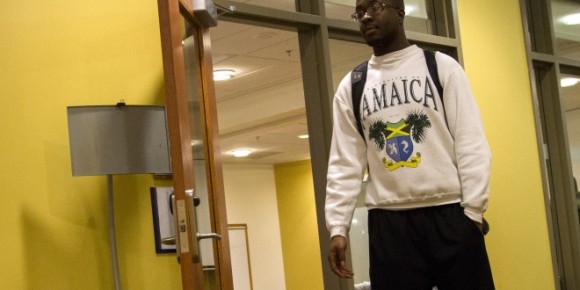
A CU student outside of a C4C conference room after attending a special Black Student Alliance (BSA) meeting Nov. 17, 2015, where the group talked about its leadership’s recent discussions with CU administration about racial issues on campus. (Danny Anderson/CU Independent)
In fall 2016, Dean of Students Akirah Bradley and DiStefano formed the Council of Black Student Leaders, which included students from other organizations as well as some BSA members.
BSA took issue with the move — not all BSA members who wanted to attend meetings were allowed to. Ferribee said two BSA officers were invited. Mendez-Wilson said the council was an effort to capture more perspectives than those of just one group. The group met throughout the semester.
Students from UMAS Y MEChA said the administration should meet with other student groups and groups that identify differently.
“We’re very happy that the experiences of BSA and black students on campus are being heard by the administration,” said Antonio Huizar, MEChA co-chair. “But if they really want to be intentional and inclusive, those meetings should be taking place with other groups on campus.”
The CU Independent also reached out to Asian Unity, Oyate Native American Students Organization, African Students Association and Caribbean Student Alliance for this story but didn’t hear back.
‘The truth has been distorted’ — one diversity dorm hall program closes, new ‘Social Justice Living’ opens in Hallett
Alongside the purported implementation of the diversity plan, students and faculty have decried another change that they say is a step back for the state of diversity on campus.
In November, CU announced that the Leadership Residential Academic Program (RAP) would close, along with two other RAPs. The Leadership RAP included two programs within it, among them the Ethnic Living and Learning Community (ELLC). RAPs are programs in which students take classes relevant to their majors in the dorms where they live. LLCs are similar, but involve only activities on certain topics rather than classes. As a whole, the Leadership RAP in the Kittredge Central dorm hall focused on “leadership through the lens of social justice,” its website said.
According to Ann Scarritt, the program’s former director, CU said it closed the program because of its cost.
The decision signaled CU’s focus on starting new programs called first-year interest groups and first-year seminars. The seminars, which CU said it was starting in spring 2017, are interactive classes limited to 19 students. The interest groups this fall will include students enrolled in two to three common classes who live in the same hall and don’t require an $850 fee like RAPs do, the Daily Camera reported in June.
Scarritt said students who couldn’t afford the fee were given a full scholarship to cover it, the Camera reported. The new programs are only open to first-semester freshman, unlike RAPs, which are open to older students too.
Five staff positions associated with the three total RAP closures were scheduled to be eliminated in May, CU’s announcement said. It also said CU “hopes to identify positions on campus into which these staff members can successfully transition.”
The initial announcement of the change Nov. 2 said that the ELLC would continue, but the entire RAP program was shut down as of June 15, according to a CU webpage.
“Provost [Moore] came to our class as one of our speakers, and someone asked him about the ELLC, and he said, ‘Oh no, we’re not taking it away — we’re just changing it,’” a student at the February UMAS Y MEChA meeting said. “And he just lied to us.”
Adán García, an UMAS Y MEChA member, said he talked to Vice Provost Mary Kraus in fall about the ELLC. Kraus oversaw the ELLC and Leadership RAP.
García said that between meetings with CU administration on the subject, he felt “the truth has been distorted.”
“It’s mainly that it wasn’t handled right,” said García, who said he worries about CU making budget cuts that affect “historically disadvantaged groups.”
As the Leadership RAP falls, two new programs in fall 2017 called the Lucille B. Buchanan and Multicultural Perspectives LLCs start up in Hallett Hall, which already works to support LGBTQIA-identified students through the Spectrum LLC program. CU has deemed Hallett a “Social Justice Living Environment,” an April news release said.
The Buchanan program will include black students and allies who want to support them, the release said, and the latter program will focus on students passionate about diversity in general. The release said the programs are open to any “students who are interested in social justice.”
Ostensibly, that change was meant to be a continuation of the Ethnic Living and Learning Community, but students and faculty were critical of the move.
“Our [curriculum] program will be transferred to the School of Education in a very limited form,” said Huizar, who said he attended an April 18 meeting with the ELLC community on the subject. “No living or community component will be kept.”
Nothing will be directly transferred from the old ELLC to the Hallett program, Mendez-Wilson said.
Scarritt sent an appeal to the university in November after the announcement. She said the decision was made without input from students, staff or faculty in the program and disputed the basis of the move.
“Administration went against the recommendations of those who were consulted, the Leadership RAP [director], the [Arts and Sciences] RAP directors and the Associate Deans of the Colleges,” Scarritt wrote in the appeal, which Huizar provided to the CUI.
Scarritt said communication from CU on the topic was “impersonal, inaccurate and misleading.”
“The public announcement stated that the RAP was under-enrolled,” Scarritt wrote. “It is always fully enrolled, with a waitlist. The only reason the RAP doesn’t grow … is due to a lack of bed space within the … hall that houses the RAP.”
Mendez-Wilson told the CUI that the provost consulted with “the appropriate authorities, including the chancellor, the deans in the Arts and Sciences and engineering colleges, as well as [Kraus].”
“Initially, it was thought that the ELLC would evolve into another first-year program … it became clear that disentangling the ELLC from the Leadership RAP would not be feasible,” Mendez-Wilson said.
A chain of emails the CUI was provided in late April between several faculty and staff — some of whom are connected to RAPs — expressed extensive concern about the change.
History before the historic plan
In November 2015, the chancellor wrote that the university is “mindful of Mizzou” as it moves forward with its diversity plan.
In contrast to CU’s actions, the University of Missouri announced that it would require “diversity and inclusion training” for first-time incoming students and all faculty and staff in the midst of its controversies Oct. 8, 2015, CNN reported.
It took Mizzou only a handful of weeks to announce it would require training in the face of racial issues.
In 2007, then-CU Boulder Chancellor G.P. “Bud” Peterson and a planning commission brainstormed ideas to improve diversity on campus, too. Among them were home visits to prospective students and encouraging minority students with good enough ACT and SAT scores to apply to CU, The Denver Post reported that January.
An idea that took off at the time was creating a vice chancellor position for diversity, equity and outreach. Boswell holds that position today — he took the spot in 2010 after another vice chancellor held it from August 2007 to June 2010.
Ten years later, CU is still having the same conversation. The 2007 Post story mentioned “occasional ugly incidents, such as a racist death threat e-mailed to a student leader” in 2006.
In January 2016, Ferribee, the former BSA co-president who has since graduated, met with DiStefano along with other students in the group to discuss racial issues and students’ concerns.
“There was a person that participated in tonight’s dialogue who [was] a student and worked for the university for 10 years,” Ferribee said at the time. “They were part of BSA when they were a student. These are the same recommendations from 10 years ago, and nothing’s happened yet.”
For Ferribee and other student leaders, time ticks on.
CU Independent News Reporters Kalley Velarde, Eliza Radeka, Maris Westrum and Heidi Harris contributed reporting for this story.
CU Independent News Editors Lucy Haggard and Kristin Oh contributed reporting for this story.
CU Independent Copy Editor Carina Julig contributed reporting for this story.
CU Independent Multimedia Managing Editor Jackson Barnett contributed reporting for this story.
CU Independent Managing Editor Jake Mauff contributed editing and reporting for this story.
CU Independent Editor-in-Chief Ellis Arnold wrote and contributed reporting for this story.
Contact the CUI at tips@cuindependent.com.
